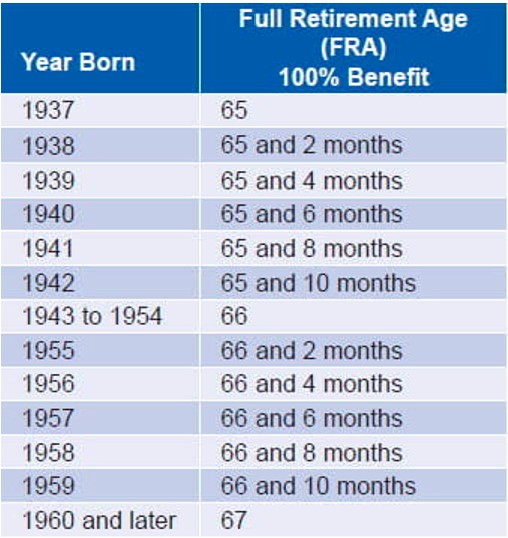Written by:

Are you nearing retirement age and wondering how to maximize your social security benefits? If so, you’re not alone. Millions of Americans are asking themselves these very same questions. This blog will discuss five tips that will help you maximize your social security benefits. Follow these tips and you’ll be closer to achieving the comfortable retirement you desire.
Tip #1: Be Aware of a Beneficial Cost-Of-Living Adjustment In 2023
As of writing in December 2022, the Social Security Administration has confirmed an 8.7% cost-of-living adjustment for social security benefits for the calendar year of 2023. This specific increase is the largest of its kind since 1981. Beneficiaries will see their monthly check increase beginning in 2023 to properly adjust with inflation—an automatic benefit for those electing.
Tip #2 Coordinate Proper Spousal Social Security Benefits
An important fact to note about spousal Social Security is that the higher benefit stays. For example, let’s assume one spouse is receiving $1,000/month from Social Security and the other spouse was receiving $3,000/month. If the spouse receiving $3,000/month passed away, provided they were married for ten years, the surviving spouse will receive $3,000/month– replacing their benefit of $1,000/month.
Tip #3 Factor In Peace-Of-Mind To Your Social Security Decision
There are many factors to consider before taking social security: your age, your spouse’s benefit, and your life expectancy among the most discussed. But one critical factor that is often overlooked is your peace-of-mind. For most high-net-worth clients, the decision to turn on social security at 67 as opposed to 70, for example, will not impact the long-term financial plan drastically. What it will impact, however, is legacy planning to beneficiaries. Generally speaking, delaying Social Security until age 70 results in a larger inheritance for beneficiaries only if lifespan extends past age 88 (assuming the difference could have been invested at a 6% rate of return in the early years). This is due to a higher monthly payment from Social Security, resulting in fewer distributions from your investment portfolio to supplement retirement income. We have found that, for most clients, it is easier to spend social security in retirement than it is to withdraw from your investment portfolio to recreate income.
Tip #4 Be Aware of Earnings Tests If Taking Social Security Before Full Retirement Age
Before determining if the social security earnings test is relevant to your financial situation, one must first understand their personal full retirement age (FRA)

If you are considering taking social security before your full retirement age, be aware that you’ll be subject to an earnings test. If your earnings exceed a certain level ($19,560 in 2022), $1 in benefits for every $2 of earnings (above $19,560) will be withheld. Make sure to consider all factors before turning on social security before your designated FRA. If your FRA is reached, then the earnings test does not apply, and you will receive your benefit in full.
Tip #5 Be Aware Of How Social Security Benefits Are Taxed
For those married filing jointly in retirement earning over $44,000 of combined income, 85% of your Social Security benefits generally will be considered taxable. Combined income consists of your adjusted gross income plus nontaxable interest plus 50% of your Social Security benefits. If you are planning to fall under this limit, it is important to note how your assets are invested. Have you accumulated significant money in a pre-tax account, like a Traditional IRA? If so, you will be subject to government mandated required minimum distributions (RMDs). These RMDs count as income in the year they are distributed and could increase earned income above the limit for Social Security taxation. Likewise, are you subject to capital gains and dividends from a taxable investment account? These will also be considered as income so be sure to note all sources of income before planning around Social Security benefits.
Your decision regarding when to take Social Security payments should be an individualized discussion based on your unique circumstances. Please consult with a financial advisor before finalizing any Social Security planning.
_______________________________________________________________________
Equilibrium Wealth Advisors is a registered investment advisor. The contents of this article are for educational purposes only and do not represent investment advice.
Stock markets are volatile, and the prices of equity securities fluctuate based on changes in a company’s financial condition and overall market and economic conditions. Although common stocks have historically generated higher average total returns than fixed-income securities over the long-term, common stocks also have experienced significantly more volatility in those returns and, in certain periods, have significantly underperformed relative to fixed-income securities. An adverse event, such as an unfavorable earnings report, may depress the value of a particular common stock held by the Fund. A common stock may also decline due to factors which affect a particular industry or industries, such as labor shortages or increased production costs and competitive conditions within an industry. For dividend-paying stocks, dividends are not guaranteed and may decrease without notice.
Past performance is no guarantee of future results. The change in investment value reflects the appreciation or depreciation due to price changes, plus any distributions and income earned during the report period, less any transaction costs, sales charges, or fees. Gain/loss and holding period information may not reflect adjustments required for tax reporting purposes. You should verify such information when calculating reportable gain or loss.
This content has been prepared for general information purposes only and is intended to provide a summary of the subject matter covered. It does not purport to be comprehensive or to give advice. The views expressed are the views of the writer at the time of issue and may change over time. This is not an offer document, and does not constitute an offer, invitation, investment advice or inducement to distribute or purchase securities, shares, units or other interests or to enter into an investment agreement. No person should rely on the content and/or act on the basis of any matter contained in this document. The tax and estate planning information provided is general in nature. It is provided for informational purposes only and should not be construed as legal or tax advice. Always consult an attorney or tax professional regarding your specific legal or tax situation.
In just 15 minutes we can get to know your situation, then connect you with an advisor committed to helping you pursue true wealth.
Add me to the weekly newsletter to say informed of current events that could impact my investment portfolio.
Important Disclosures:
Securities and advisory services offered through EWA LLC dba Equilibrium Wealth Advisors (a SEC Registered Investment Advisor).
* Government bonds and Treasury Bills are guaranteed by the U.S. government as to the timely payment of principal and interest and, if held to maturity, offer a fixed rate of return and fixed principal value. However, the value of fund shares is not guaranteed and will fluctuate.
* Corporate bonds are considered higher risk than government bonds but normally offer a higher yield and are subject to market, interest rate and credit risk as well as additional risks based on the quality of issuer coupon rate, price, yield, maturity, and redemption features.
* The Standard & Poor’s 500 (S&P 500) is an unmanaged group of securities considered to be representative of the stock market in general. You cannot invest directly in this index.
* All indexes referenced are unmanaged. The volatility of indexes could be materially different from that of a client’s portfolio. Unmanaged index returns do not reflect fees, expenses, or sales charges. Index performance is not indicative of the performance of any investment. You cannot invest directly in an index.
* The Dow Jones Global ex-U.S. Index covers approximately 95% of the market capitalization of the 45 developed and emerging countries included in the Index.
* The 10-year Treasury Note represents debt owed by the United States Treasury to the public. Since the U.S. Government is seen as a risk-free borrower, investors use the 10-year Treasury Note as a benchmark for the long-term bond market.
* Gold represents the afternoon gold price as reported by the London Bullion Market Association. The gold price is set twice daily by the London Gold Fixing Company at 10:30 and 15:00 and is expressed in U.S. dollars per fine troy ounce.
* The Bloomberg Commodity Index is designed to be a highly liquid and diversified benchmark for the commodity futures market. The Index is composed of futures contracts on 19 physical commodities and was launched on July 14, 1998.
* The DJ Equity All REIT Total Return Index measures the total return performance of the equity subcategory of the Real Estate Investment Trust (REIT) industry as calculated by Dow Jones.
* The Dow Jones Industrial Average (DJIA), commonly known as “The Dow,” is an index representing 30 stock of companies maintained and reviewed by the editors of The Wall Street Journal.
* The NASDAQ Composite is an unmanaged index of securities traded on the NASDAQ system.
* International investing involves special risks such as currency fluctuation and political instability and may not be suitable for all investors. These risks are often heightened for investments in emerging markets.
* Yahoo! Finance is the source for any reference to the performance of an index between two specific periods.
* The risk of loss in trading commodities and futures can be substantial. You should therefore carefully consider whether such trading is suitable for you in light of your financial condition. The high degree of leverage is often obtainable in commodity trading and can work against you as well as for you. The use of leverage can lead to large losses as well as gains.
* Opinions expressed are subject to change without notice and are not intended as investment advice or to predict future performance.
* Economic forecasts set forth may not develop as predicted and there can be no guarantee that strategies promoted will be successful.
* Past performance does not guarantee future results. Investing involves risk, including loss of principal.
* The foregoing information has been obtained from sources considered to be reliable, but we do not guarantee it is accurate or complete.
* There is no guarantee a diversified portfolio will enhance overall returns or outperform a non-diversified portfolio. Diversification does not protect against market risk.
* Asset allocation does not ensure a profit or protect against a loss.
* Consult your financial professional before making any investment decision.
In 15 minutes we can get to know you – your situation, goals and needs – then connect you with an advisor committed to helping you pursue true wealth.
EWA, LLC dba Equilibrium Wealth Advisors, is an SEC-registered investment advisory firm providing investment advisory and financial planning services to clients.
Investments in securities and insurance products are not insured by any state or federal agency.
To view EWA’s public disclosure, registration, Form ADV and Part 2B’s, click here.
To view EWA’s Client Relationship Summary (CRS), click here.
COPYRIGHT 2024 EWA, LLC. ALL RIGHTS RESERVED
In 15 minutes we can get to know you – your situation, goals and needs – then connect you with an advisor committed to helping you pursue true wealth.